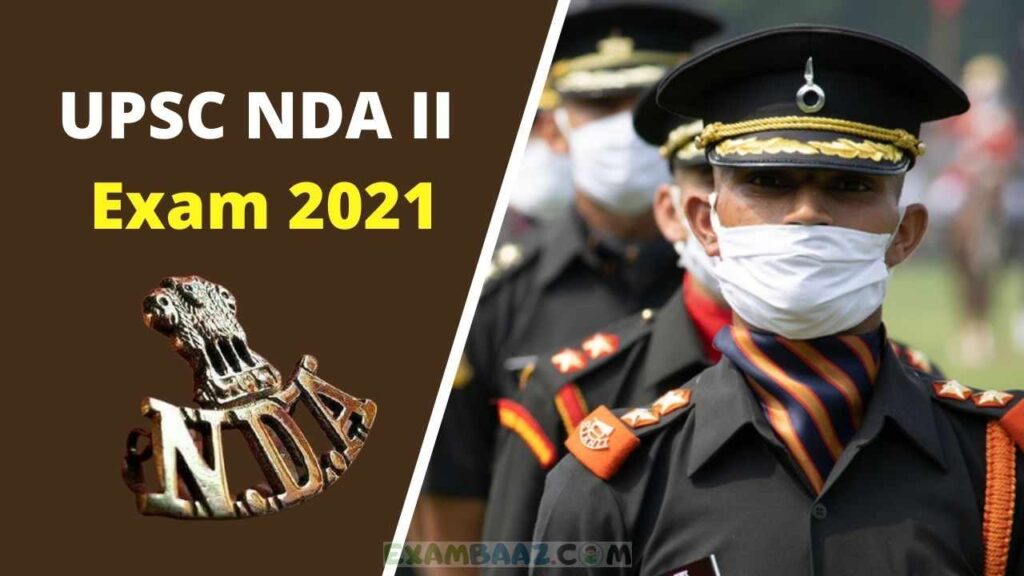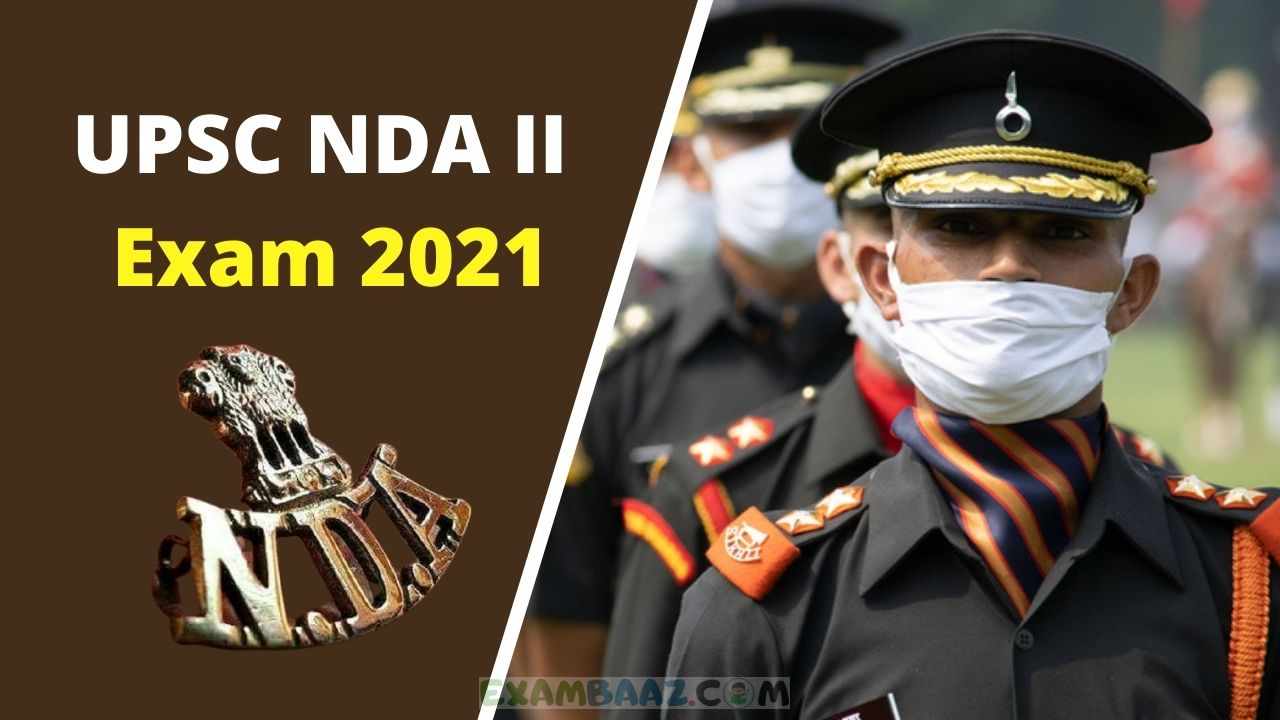Are you in search of UPSC NDA 2 Exam Syllabus 2021? Then you are in the right place. The Union Public Service Commission (UPSC) has released the 400 vacancies for admission to the Army, Navy, and Air Force wings of the NDA for the 148th Course, and for the 110th Indian Naval Academy Course (INAC) commencing from 2nd July 2022.
Read More: NDA परीक्षा 2021 की तैयारी केसे करे? || जाने सभी महत्वपूर्ण जानकरी
In this article, you can get the complete details about the UPSC NDA 2 Exam Syllabus, Exam Pattern and selection process 2021, and more.
Important Dates for UPSC NDA 2 Exam 2021-22
- Starting Date for Apply Online: 09-06-2021
- Last Date to Apply Online: 29-06-2021 till 06:00 pm
- Last Date for Fee Payment (by cash): 28-06-2021 till 23:59 pm
- Last Date for Fee Payment (Online): 29-06-2021 till 06:00 pm
- Date for online application Withdrawn: 06 to 12-07-2021 till 6:00 pm
- Date of Exam: 05-09-2021
- Date of Declaration of Exam Result: December 2022
- Course Commencing From: 02-07-2022
Vacancy Details (UPSC NDA 2 Exam 2021-22)
Total Vacancy- 400
National Defence Academy – 370 to include 208 for Army, 42 for Navy and 120 for Air Force (including 28 for ground Duties)
Naval Academy (10+2 Cadet Entry Scheme) – 30
Selection Process for UPSC NDA 2 2021
The candidate selection process has two stages-
- Written Test – 900 Marks
- SSB Interview/Personality Test – 900 Marks
UPSC NDA 2 Exam Pattern
UPSC NDA 2 Exam consists of two papers Maths and General Ability Test both paper have 2 Hours & 30 Minutes time. check out the UPSC NDA 2 Exam Pattern in the table given below.
| Subject | No. of Questions | Marks | Time |
| Maths (Post Code – 01) | 120 | 300 | 2 Hours & 30 Minutes |
| General Ability Test (Post Code – 02) | 150 | 600 | 2 Hours & 30 Minutes |
New SyllabusUPSC NDA 2 Exam 2021-22 New Syllabus
Part 1 – Mathematics
ALGEBRA: Concept of set, operations on sets, Venn diagrams. De Morgan laws, Cartesian product, relation, equivalence relation. Representation of real numbers on a line. Complex numbers—basic properties, modulus, argument, cube roots of unity. Binary system of numbers. Conversion of a number in decimal system to binary system and vice-versa. Arithmetic, 19 Geometric and Harmonic progressions. Quadratic equations with real coefficients. Solution of linear inequations of two variables by graphs. Permutation and Combination. Binomial theorem and its applications. Logarithms and their applications.
MATRICES AND DETERMINANTS: Types of matrices, operations on matrices. Determinant of a matrix, basic properties of determinants. Adjoint and inverse of a square matrix, Applications-Solution of a system of linear equations in two or three unknowns by Cramer’s rule and by Matrix Method.
TRIGONOMETRY: Angles and their measures in degrees and in radians. Trigonometrical ratios. Trigonometric identities Sum and difference formulae. Multiple and Sub-multiple angles. Inverse trigonometric functions. Applications-Height and distance, properties of triangles.
ANALYTICAL GEOMETRY OF TWO AND THREE DIMENSIONS: Rectangular Cartesian Coordinate system. Distance formula. Equation of a line in various forms. Angle between two lines. Distance of a point from a line. Equation of a circle in standard and in general form. Standard forms of parabola, ellipse and hyperbola. Eccentricity and axis of a conic. Point in a three dimensional space, distance between two points. Direction Cosines and direction ratios. Equation two points. Direction Cosines and direction ratios. Equation of a plane and a line in various forms. Angle between two lines and angle between two planes. Equation of a sphere.
DIFFERENTIAL CALCULUS : Concept of a real valued function–domain, range and graph of a function. Composite functions, one to one, onto and inverse functions. Notion of limit, Standard limits—examples. Continuity of functions—examples, algebraic operations on continuous functions. Derivative of function at a point, geometrical and physical interpretation of a derivative—applications. Derivatives of sum, product and quotient of functions, derivative of a function with respect to another function, derivative of a composite function. Second order derivatives. Increasing and decreasing functions. Application of derivatives in problems of maxima and minima.
INTEGRAL CALCULUS AND DIFFERENTIAL EQUATIONS : Integration as inverse of differentiation, integration by substitution and by parts, standard integrals involving algebraic expressions, trigonometric, exponential and hyperbolic functions. 20 Evaluation of definite integrals—determination of areas of plane regions bounded by curves—applications. Definition of order and degree of a differential equation, formation of a differential equation by examples. General and particular solution of a differential equations, solution of first order and first degree differential equations of various types—examples. Application in problems of growth and decay.
VECTOR ALGEBRA : Vectors in two and three dimensions, magnitude and direction of a vector. Unit and null vectors, addition of vectors, scalar multiplication of a vector, scalar product or dot product of two vectors. Vector product or cross product of two vectors. Applications—work done by a force and moment of a force and in geometrical problems.
STATISTICS AND PROBABILITY : Statistics : Classification of data, Frequency distribution, cumulative frequency distribution—examples. Graphical representation—Histogram, Pie Chart, frequency polygon— examples. Measures of Central tendency—Mean, median and mode. Variance and standard deviation—determination and comparison. Correlation and regression. Probability : Random experiment, outcomes and associated sample space, events, mutually exclusive and exhaustive events, impossible and certain events. Union and Intersection of events. Complementary, elementary and composite events. Definition of probability—classical and statistical—examples. Elementary theorems on probability—simple problems. Conditional probability, Bayes’ theorem—simple problems. Random variable as function on a sample space. Binomial distribution, examples of random experiments giving rise to Binominal distribution.
PAPER 2 – General Ability Test
Part ‘A’—ENGLISH (Maximum Marks—200) – Grammar and usage, vocabulary, comprehension and cohesion in extended text to test the candidate’s proficiency in English.
2.Part ‘B’—GENERAL KNOWLEDGE (Maximum Marks—400) – There will be questions on following subjects:
Physics – Physical Properties and States of Matter, Mass, Weight, Volume, Density and Specific Gravity, Principle of Archimedes, Pressure Barometer. Motion of objects, Velocity and Acceleration, Newton’s Laws of Motion, Force and Momentum, Parallelogram of Forces, Stability and Equilibrium of bodies, Gravitation, elementary ideas of work, Power and Energy. Effects of Heat, Measurement of Temperature and Heat, change of State and Latent Heat, Modes of transference of Heat. Sound waves and their properties, Simple musical instruments. Rectilinear propagation of Light, Reflection and refraction. Spherical mirrors and Lenses, Human Eye. Natural and Artificial Magnets, Properties of a Magnet, Earth as a Magnet. Static and Current Electricity, conductors and Nonconductors, Ohm’s Law, Simple Electrical Circuits, Heating, Lighting and Magnetic effects of Current, Measurement of Electrical Power, Primary and Secondary Cells, Use of X-Rays. General Principles in the working of the following: Simple Pendulum, Simple Pulleys, Siphon, Levers, Balloon, Pumps, Hydrometer, Pressure Cooker, Thermos Flask, Gramophone, Telegraphs, Telephone, Periscope, Telescope, Microscope, Mariner’s Compass; Lightening Conductors, Safety Fuses.
Chemistry: Physical and Chemical changes. Elements, Mixtures and Compounds, Symbols, Formulae and simple Chemical Equations, Law of Chemical Combination (excluding problems). Properties of Air and Water. Preparation and Properties of Hydrogen, Oxygen, Nitrogen and Carbondioxide, Oxidation and Reduction. Acids, bases and salts. Carbon—different forms. Fertilizers—Natural and Artificial. Material used in the preparation of substances like Soap, Glass, Ink, Paper, Cement, Paints, Safety Matches and GunPowder. Elementary ideas about the structure of Atom, Atomic Equivalent and Molecular Weights, Valency.
General Science: Difference between the living and non-living. Basis of Life—Cells, Protoplasms and Tissues. Growth and Reproduction in Plants and Animals. Elementary knowledge of Human Body and its important organs. Common Epidemics, their causes and prevention. Food—Source of Energy for man. Constituents of food, Balanced Diet. The Solar System—Meteors and Comets, Eclipses. Achievements of Eminent Scientists.
History, Freedom Movement etc. – A broad survey of Indian History, with emphasis on Culture and Civilisation. Freedom Movement in India. Elementary study of Indian Constitution and Administration. Elementary knowledge of Five Year Plans of India. Panchayati Raj, Co-operatives and Community Development. Bhoodan, Sarvodaya, National Integration and Welfare State, Basic Teachings of Mahatma Gandhi. Forces shaping the modern world; Renaissance, Exploration and Discovery; War of American Independence. French Revolution, Industrial Revolution and Russian Revolution. Impact of Science and Technology on Society. Concept of one World, United Nations, Panchsheel, Democracy, Socialism and Communism. Role of India in the present world.
Geography – The Earth, its shape and size. Lattitudes and Longitudes, Concept of time. International Date Line. Movements of Earth and their effects. Origin of Earth. Rocks and their classification; Weathering—Mechanical and Chemical, Earthquakes and Volcanoes. Ocean Currents and Tides Atmosphere and its composition; Temperature and Atmospheric Pressure, Planetary Winds, Cyclones and Anti-cyclones; Humidity; Condensation and Precipitation; Types of Climate, Major Natural regions of the World. Regional Geography of India—Climate, Natural vegetation. Mineral and Power resources; location and distribution of agricultural and Industrial activities. Important Sea ports and main sea, land and air routes of India. Main items of Imports and Exports of India.
Current Events – Knowledge of Important events that have happened in India in the recent years. Current important world events. Prominent personalities—both Indian and International including those connected with cultural activities and sports. 23 NOTE : Out of maximum marks assigned to part ‘B’ of this paper, questions on Sections ‘A’, ‘B’, ‘C’, ‘D’, ‘E’ and ‘F’ will carry approximately 25%, 15%, 10%, 20%, 20% and 10% weightages respectively.
Intelligence and Personality Test 2021
Shortlisted candidates in the written exam will be called for Intelligence and Personality Test conducted by Services Selection Board (SSB) in two stages:
- Stage I comprises of Officer Intelligence Rating (OIR) tests are Picture Perception * Description Test (PP&DT). The candidates will be shortlisted based on a combination of performance in the OIR Test and PP&DT.
- Stage II Comprises of Interview, Group Testing Officer Tasks, Psychology Tests, and the Conference. These tests are conducted over 4 days. The details of these tests are given on the website joinindianarmy.nic.in.
The personality of a candidate is assessed by three different assessors viz. The Interviewing Officer (IO), Group Testing Officer (GTO), and the Psychologist. There is no separate weightage for each test. The marks are allotted by assessors only after considering the performance of the candidate holistically in all the tests. In addition, marks for Conference are also allotted based on the initial performance of the Candidate in the three techniques and the decision of the Board. All these have equal weightage. The various tests of IO, GTO, and Psych are designed to bring out the presence/absence of Officer Like Qualities and their trainability in a candidate. Accordingly, candidates are Recommended or Not Recommended at the SSB.
UPSC NDA 2 Exam 2021: Frequently Asked Questions

NDA-2 is generally easier as candidates are 12th appearing, so syllabus coverage by candidates is less. Hence, cutoffs are lower. NDA-1 is more difficult in general because the candidates are 12th pass and have covered the entire syllabus since they have already given their board exam at that point. Therefore, cutoffs are higher (in general), and competition is intense.
Yes, you can apply for NDA while pursuing your 12th grade. You must check your date of birth also whether you are eligible or not.
Yes, you will be called. But it’s better for you to give NDA 2 in September because if you give NDA 1 in April, you cannot join the academy as it requires candidates who have passed 12th.
For Latest Update Please join Our Social media Handle
| Follow Facebook – Click Here |
| Join us on Telegram – Click Here |
| Follow us on Twitter – Click Here |
